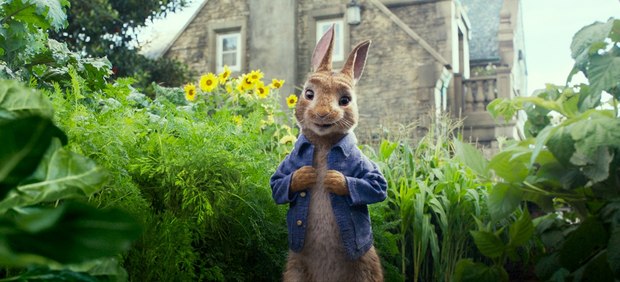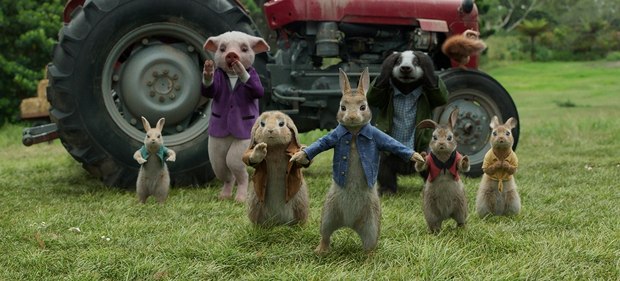AWN’s The Miscweant takes a deep dive into Sony Pictures Animation’s modern-day take on the classic story by Beatrix Potter.
It’s been a long time since I read Beatrix Potter’s bunny tales to my kids (they haven’t been kids for a decade or two now, as a matter of fact); Potter’s stories aren’t as clear in my mind as the once were. Even so, the film’s advertising campaign (“RASCAL REBEL RABBIT”) made it pretty clear this isn’t your father’s Peter.
It’s a dicey proposition, updating and expanding beloved children’s books into feature films. Picture books that can be read in minutes can become quite funny animated shorts but tend to show the strain of supporting a 90-minute narrative. (Compare the Disney’s Ferdinand or Looney Tunes’ Horton Hatches the Egg shorts to Blue Sky’s feature versions (I know Blue Sky did Hears a Who! and not Egg, but you get the idea.)
Fortunately, the live-action/CGI combo Peter Rabbit has no such problem because the film has basically thrown away everything Potter wrote, save the animals themselves who now live in contemporary times and possess an astonishing degree of self-awareness. It’s not quite The Lego Batman Movie, but when the animals discuss their own and each other’s “character flaws” or criticize Benjamin Bunny’s brown-on-brown fashion sense (because he’s wearing the same jacket Potter drew him wearing in 1902) you definitely know you’re watching, to say the least a less than faithful adaptation.
Purists’ (or anyone with an emotional attachment to the original books) heads may explode, but I had a blast watching this movie. Right off the bat the film lets you know where it’s coming from when a scurrying Peter crashes into a flock of birds, interrupting their Disney-style self-affirmation song (“you’re only as small as your dreams,” or lyrics to that effect) while fleeing a pursuing fox. (The birds return later on, performing much more contemporary-style songs including a rap number or two.) As the film’s publicity puts it, Peter Rabbit is now an “irreverent, contemporary comedy with attitude.” It’s the kind of puffery that usually sets my teeth on edge (especially when they add “edgy”), but to Sony Pictures Animation’s credit they pulled it off.
If the interrupted avian production number wasn’t clue enough, the movie wastes no time in (SPOILER ALERT, but this happens mere minutes into the film and sets its narrative in motion) killing off Peter’s nemesis Old Mr. McGregor via a life-saving (for Peter that is) fatal heart attack. (This takes place moments after Peter contemplates invading McGregor’s exposed butt cleavage with a well-aimed carrot.) I seem to remember a National Lampoon story that had Mr. McGregor and Peter engaging in open, violent warfare; probably not an inspiration but the movie definitely reminded me of it.
Peter and company are far from out of the woods, so to speak, when McGregor’s great-nephew Thomas arrives and promptly becomes Peter’s new nemesis. The film wisely avoids making the fastidious Thomas a stock villain, giving him sympathetic qualities from the get-go and putting the audience on his side after he’s unfairly denied a promotion at London’s famed Harrod’s department store.
Thomas soon meets the occasionally clueless “Bea” (yeah, I know -- and she paints portraits of Peter and friends that are perfect ringers for Beatrix Potter’s original art), the animals’ protector. As she reminds Thomas, “they were here before we arrived.” Much to Peter’s chagrin, she and Thomas hit it off, a relationship that Peter fears will weaken his bond with Bea; the rivalry between man and rabbit is now over more than a vegetable garden.
While the film may have chucked Potter’s whimsical storytelling, the CGI animals’ appearance is fully faithful to her original art -- a detail underscored when the film occasionally transforms them into 2D-animated versions of their storybook selves. Peter Rabbit’s studio, the perfectly named Animal Logic successfully walked the tightrope of endowing their CGI versions with human expressiveness while adding the fur, feathers and whiskers of their real-world counterparts.
TVTtropes.com defines “lampshading” as dealing with a “particularly blatant use of a trope by calling attention to it and simply moving on” -- and there’s more than a bit of it in Peter Rabbit. My favorite moment is when a close-to-losing-it Thomas hollers “where do they get the jackets?” but there’s also a cliché-busting moment where Peter and friends are walking towards the camera in heroic slow motion (as first seen in The Right Stuff) and are interrupted by a hedgehog commenting on their sluggish gait.
There’s also plenty of cartoony/Home Alone-style violence in Peter Rabbit with electric shocks that send various characters flying or the animals’ sustained slingshot assault on Thomas’s crotch. (Thankfully, the closest the film gets to a fart joke is including the word “flatulent” in the dialog.) Silly moments abound as well, as when Peter and cousin Benjamin Bunny return from London loaded down with kitschy souvenirs, or when Thomas “hurries” back via a quick montage of him travelling via boat, plane and railroad handcar.
Early on I mentioned the film avoids making Thomas a stock villain. Silliness aside, it’s a telling moment of the film’s self-awareness when the furious human finally gets his hands on Peter and grimly tells him “I am not a bad guy – you turned me into a bad guy” and the rabbit realizes he’s crossed a few lines too many himself. If only more films, animated or otherwise were willing to make their “hero” and “villain” something other than polar opposites on the morality scale.
















